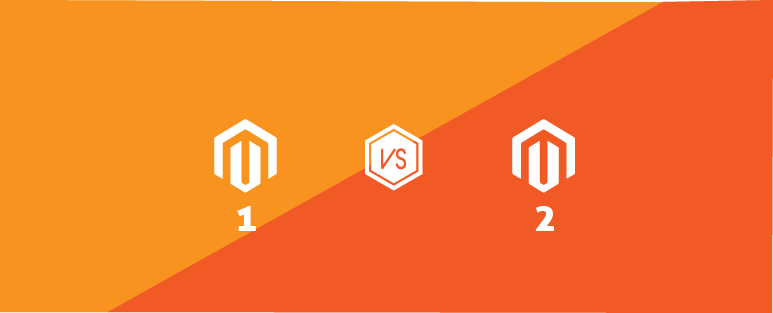5 Reasons Why Magento 2 is Better Than Magento 1
Here you will find 5 Reasons Why Magento 2 is Better Than Magento 1. Don't wait for Magento 1 to stop support. Migrate now!
3 min read
 Tim Bucciarelli
:
September 27, 2018
Tim Bucciarelli
:
September 27, 2018

The eCommerce industry is growing rapidly, with online shopping becoming the go-to option for many customers. Roughly 80 percent of Americans have made an online purchase in the last month, and 96 percent have done so at some point in their life. Online storefronts aren’t just for big businesses. In fact, small retailers can see mobile conversion rates 30 percent higher than their larger competitors. If your business offers online retail, migrating to Magento may be just what you need.
For those performing in this highly competitive space, it’s important to keep up with the latest trends and tools. Though you may have chosen your current platform carefully when you set up shop, you may find later on that you need something more. If you’re getting ready to migrate to the flexible and scalable Magento eCommerce platform, here’s what you need to know for a smooth move.
Choosing an eCommerce platform is no small task. You likely put a great deal of time and thought into your current setup, which can make it difficult to commit to a migration. While you don’t want to go to the trouble of migrating your store to a new platform without reason, there are some good indicators that will let you know it’s time for a change. Here are a few key signs that you should think about changing platforms:
If your current platform isn’t delivering in one or more of these critical ways, it’s time to consider a migration to something that will serve you better. Magento is a powerful, flexible, scalable platform that’s ideal for businesses that have outgrown simpler eCommerce platforms.
Many online retailers start with WooCommerce because of its association with WordPress. Designed as a WordPress plugin, WooCommerce is particularly easy to use if your website is hosted on WordPress. WooCommerce also has the benefit of being free and intuitive. Unfortunately, WooCommerce is better as a starter store than one designed to support a large number of products and heavy sales traffic.
As your company grows, so, too, will your eCommerce needs. Magento is a more powerful platform that’s designed for scalability. You’ll find you can easily host a large store through this platform, providing your customers with outstanding security, reliability, and ease of use. Magento integrates easily with many payment providers including Google payments, PayPal, Braintree, and Authorize.net.
When migrating to Magento from WooCommerce, it’s important to carefully consider the information you want to migrate. You can transfer your product data, product categories, customer information, order information, SEO URLs, product reviews, tax rules, and more. However, you may not want to move everything. This is a prime opportunity for scaling down on unnecessary data and reorganizing your information for greater efficiency with your new system.
If you’re looking for more flexibility, migrating to Magento from OpenCart may offer what you need. Magento’s community is larger than OpenCart’s. While both are open-source programs, you’ll enjoy more options and opportunities within Magento. Magento also certifies its developers, so it’s easier to find reliable professionals to work with.
Migrating to Magento gives you unlimited potential for customization. Magento Commerce offers a wealth of plugins and design options to help you create the store of your dreams. In the rare instance where you can’t find what you’re looking for, you’ll usually find that an experienced Magento developer can custom build the right solution for you. Magento does come with its complexities, but these are easily managed if you have a good developer on your team.
Between the two, Magento is also the leader in SEO. OpenCart’s SEO functionality is still relatively limited, while Magento lets you optimize images, titles, and URLs, so you can drive traffic more efficiently to your store and make it easier for shoppers to find what they’re looking for.
You can migrate directly from OpenCart to Magento using any of several extensions or tools to smooth parts of the process. As with any migration, it’s important to plan ahead, so you have a clear timeline for every step of the migration. This helps you avoid as many growing pains as possible.
Shopify is a hosted commercial product where the details of setting up and maintaining a virtual storefront are primarily taken care of for you. Magento, meanwhile, is open-source software that’s supported by the Magento community. If you believe your online store has too much of a cookie-cutter appearance, migrating to Magento will provide the freedom and flexibility you’re craving. You’ll enjoy a new level of control over how your site looks, feels, and functions.
When you’re making this move, it’s particularly important to lay out all the features you want your Magento store to have. Shopify’s rigidity may have prevented you from thinking outside the box. With Magento, your developers can achieve nearly any look and feel. Make sure you have a clear idea of how your shop should function, taking into account everything from product organization to branding. The move to Magento offers a wealth of possibilities for new enhancements. Make sure you’re making the most of it in your initial migration so you don’t end up rebranding twice.
If your current eCommerce platform isn’t meeting your needs, don’t hesitate to make a switch. Migrating to Magento isn’t nearly as complicated as many online retailers fear. With proper planning, you can move seamlessly from your existing setup to one that’s far better equipped to keep pace with your growing company.

Here you will find 5 Reasons Why Magento 2 is Better Than Magento 1. Don't wait for Magento 1 to stop support. Migrate now!

There are many reasons to move your site to the "mobile friendly" zone. Here we are going to share with you the most important ones.

Why you need a Magento 2 developer: Not all eCommerce business have the same site requirements. Find out what makes up the difference.